By Carl Goodwin
The following article is excerpted from a 12-page feature appearing in Vol. 44., No. 3 of Automobile Quarterly, an issue that includes the RLTF Alfa Romeo by Beverly Rae Kimes and seven other articles by leading writers. To order this and other issues, contact AQ www.autoquarterly.com
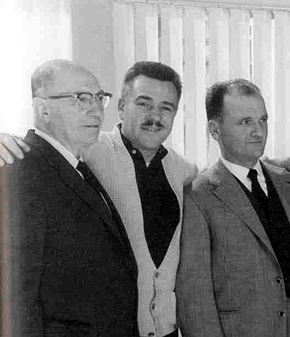
Photos of Pompeo are rare. At Daytona in January of 1960, Pompeo was photographed with Vick Lukens, center, and Ilario Bandini, at right. Courtesy Dr. Dino Bandini, from the book "Bandini".
|
Tony Pompeo lived the American dream. He immigrated to America, started a successful business, and led a prosperous life. He even won the lottery. Then he went back to Italy.
While still in America, Pompeo left a deep footprint in the realm of automotive dealers and importers. He imported most of the cars that John de Boer, Stu Schaller, Len Frank and others have called the "Etceterinis" – those little Italian
machines that are categorically indefinable. They're not Maseratis, they're not Ferraris, they're not Alfa Romeos, Lancias or Fiats. Even so, it's not completely incorrect to say that they are cars with the heart of Ferrari, the soul of Maserati, the beauty of Alfa and the spirit of Lancia.
Etceterinis are wonderful little cars in their own right, with their own fine qualities and distinct personalities. Much the same can be said of Tony Pompeo.
Pompeo was the East Coast importer of SIATA, Bandini, Stanguellini (before Sandy McArthur or Alfred Momo sold the Formula Juniors), Abarth, Cisitalia, Nardi, Moretti, Ermini, Giaur and, on a few occasions, Alfa Romeo and Maserati. According to early race worker Gary Ford, he also brought one of the first Ferrari into the U.S. It was #002C originally bought by Dr. Sam Scher and now owned by Jim Glickenhaus. Pompeo also brought in the Ermini that Californian Jim Orr campaigned. This Ermini was the Scaglietti-bodied car (looking very much like their Ferrari Monza) that Bill Devin made a mold from in about 1956 and sold for years. In short, Pompeo was the East Coast Ernie McAfee.
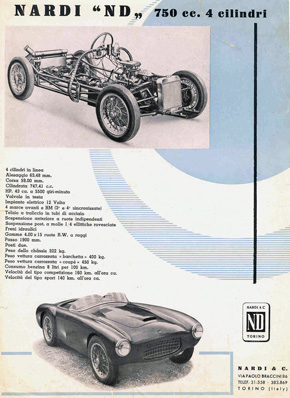
An ad for Nardis of the era, which Pompeo was able to import due to his Italian contacts.
|
Unlike Hoffman, J.S. Inskip, Arnolt, Momo or Grossman, all of Pompeo's imports were racing cars, with one or two exceptions such as the Siata Daina coupe with the upright grille that was included in Arthur Drexler's "Eight Cars" exhibit at the Museum of Modern Art.
Pompeo had numerous business locations over the years, all of them in New York City except the last two, in Connecticut. "Tony moved around," Otto Linton recalls. "He lived in Wilkes Barre during the war. He knew other Italians and moved to New York. He was on 54th Street, an office with storage. The office was a floor above Luigi Chinetti's Ferrari dealership."
Bridgehampton founder Bruce Stevenson, who had helped Pompeo get his business off the ground, recognized that Pompeo "did not know English well and he had difficulty with officialdom, so I interceded for him. He was an exceptionally nice Italian, even though he couldn't drive worth beans. Through people he knew in Italy, he had access to any car."
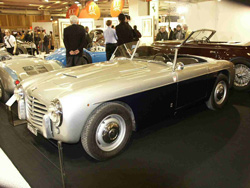
The popular Siata Gran Sport, also imported by Pompeo. Photo by Alessandro Gerelli.
|
A mainstay Pompeo import was Siata. With prices of $2,800 for the Siata Spyder with no engine, $4,200 for the Gran Sport and $5,300 for the 208S none of Tony's cars were cheap. Production of the 208 ended in 1954, when all the 2-liter 8V engines had been used up. This was also the end of all the good sports models from Siata but, of course, Pompeo had other things to sell.
Pompeo was not known for lavish parts support. Chuck Stoddard once helped to race-prepare the Siata 208S roadster of Col. Bob Kuhn, a fellow Air Force officer. While in New York, they dropped in on Tony Pompeo. Stoddard said "Colonel Kuhn, here, has a 208. Will you show us to your parts department?"
"Certainly," replied Pompeo, "follow me." Arriving at a small room in the warehouse, Tony announced, "Here it is. Just let me know what you want." Stoddard reports that the room held ten boxes of miscellaneous parts for the variety of cars that the business handled.
Pompeo could get away with such "service" because everybody liked him. "He was a nice little man," says OSCA driver Frank Bott. "The opposite of Max Hoffman." Bott adds with a smile, "Tony was quite a ladies’ man, by the way,"
"Around 1950," Bruce Stevenson recalls, "Tony had all his cars up at Jim Pauley’s garage in Banksville, New York. He had them tuned there. A fire broke out, under suspicious circumstances, and burned up the whole collection. Tony was a very easy-going guy and he just shrugged when that happened."
"He did not have the stature that some of the other importers did," says former Fiat and Alfa engineer Don Black. "But he was a prominent figure in the early fifties. They all had different motives. Max Hoffman had the profit motive. Pompeo just loved cars. No one ever said a bad word about him. He was a wonderful person."
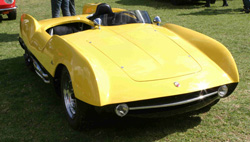
Pompeo also brought in a number of Abarth 207As, such as this one. Photo courtesy William Edgar.
|
"Tony Pompeo?" says Abarth guru Gerry Rothman. "Yes, I remember him vividly. He was quite a character. I saw him race several times at Thompson Speedway in Connecticut in the fifties. He had a showroom on Broadway in New York City.
"Foremost of Pompeo’s Italian pals," says George Jasberg, "was John Perona, who ran the famous night club 'El Morocco', one of the top five NYC night clubs."
Perona was a patron of motorsports and once ordered a very special Siata from Tony Pompeo, a large roadster that was Chrysler-powered (the early 331 hemi). The transmission for it was the same one that Briggs Cunningham later ordered for the C-4R and C-5R.
Like many early sports car distributors, Pompeo used racing to promote his business. One early race was The General Peron Grand Prix in Buenos Aires in March, 1951. He was expected to drive but did not. "Pompeo had a Nardi- Alfa Coupe," says VSCCA secretary Tony Carroll. "He and a group of SCCA drivers brought their cars to Argentina. This is the race that John Fitch won in an Allard J-2. Pompeo had Hal Ullrich from Chicago driving the car, and it placed10th." The Alfa engine had been replaced by a Chevrolet inline six with a Wayne cylinder head.
While Ernie McAfee was an accomplished racing driver, one might say that Pompeo raced in a far more casual way, as Otto Linton notes: "Tony tried his luck in racing, but flipped a beautiful Cisitalia coupe at the Glen. I seem to remember 1949 or 1950, after which I believe he somewhat curtailed his driving himself and gave a few of us a chance to drive his imports."
According to George Jasberg, "Tony Pompeo frequently entered two or more cars – Alfas, Fiats, Cisitalias and finally Siatas. I recall that his successes as a driver were few."
Pompeo also sold a number of used cars, as John de Boer found in back issues of "Pit Talk," including Ferrari 2.5, 2.7, 4.1 and 4.5, a Testa d'Oro "Tipo A", several Siatas and Bandinis.
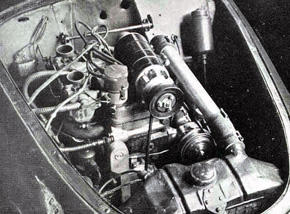
The Testa d'Oro engine--based on the Fiat Topolino.
|
Corvette Champion Frank Dominianni had a number of business deals with Pompeo back in the days when he drove a Giaur. "I bought 300 Italmeccanica superchargers from him one time. I sold and installed them for every variety of car including Cadillacs, Fords and Studebakers."
In 1955, Pompeo's order to Carlo Abarth for ten of the futuristic-looking 207A Spyders started Abarth off as a series constructor of cars. The ten 207s were followed by the 750 Zagato Abarth in 1956.
Also in 1956, Pompeo sold a Lotus 11 to Briggs Cunningham, and two more to other American drivers. Jay Sloane, owner of the last of Pompeo’s Lotus 11s, says that "half a dozen elevens and a few Mark 9s" were sold by Pompeo. "He was also involved with the Mark 6s," he adds. The original Mk 6s, Lotus authority Pat Dennis notes, were brought in by Gunnard Rubini, a Toledo, Ohio car dealer.
Pompeo's last hurrah in racing did not involve him so much as a car he had sold. Doug Diffenderfer of Bethesda, MD, was an MG racer, with a TD in 1954 and an MG-A in 1957. Then he came across an ex-Pompeo Siata 208 at Otto Linton's dealership. As Linton remembers, "he was a very good driver." According to Nan, Doug's wife, Diffenderfer's Siata won twice at Vineland, NJ, and at Bridgehampton, Lime Rock, Pocono and VIR, to take the SCCA national F-Production championship in 1960.
Pompeo’s final business move was to Milford, Connecticut. There was the expected usual array of wonderful little Italian cars, reminiscent of photographer Tom Burnsides’ comment "he was the only one importing toy cars." These included one that looked very much like a FIAT-Abarth Zagato but it had a Bandini badge on the nose.
"Some time in the mid-sixties, Tony closed up his business and went back to Italy," Don Black says. "I used to see him in Milan. Then one time I couldn’t locate him, so I asked some of the Alfa people to look for him. He was nowhere to be found. This was about 1968."
"The last I heard of Tony," Dick Irish recalls, "Isabelle (Haskell) de Tomaso told me he was working at the American Embassy in Rome as an interpreter. This would have been in the late '60s."
There’s no reason to doubt de Tomaso and, with Tony Pompeo, you never knew where he'd turn up…or where he wouldn’t.
This article is dedicated to the memory of Danny Collins, tireless worker for the benefit of the sport in the Colorado Region SCCA, accomplished racing driver, Denver-based driving instructor and writer of racing history. Adios, Danny.



